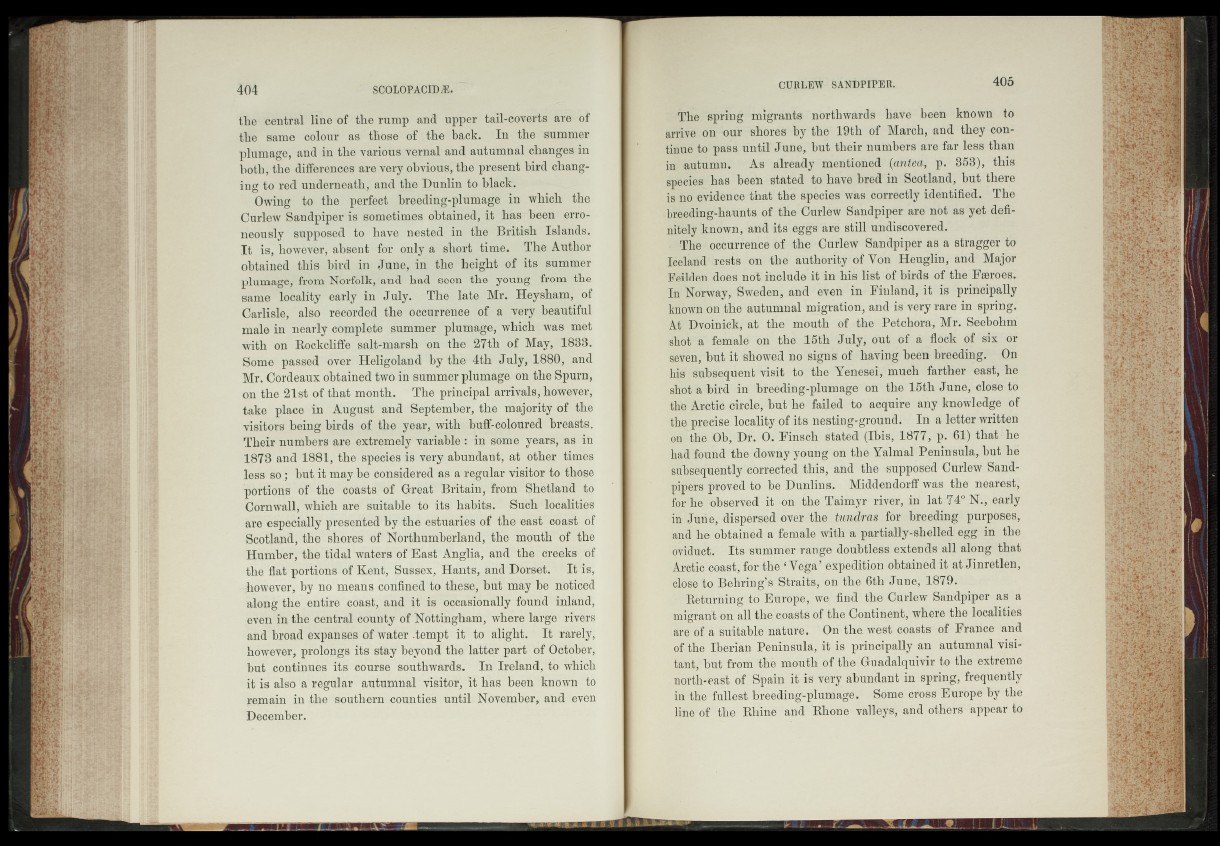
the central line of the ramp and upper tail-coverts are of
the same dolour as those of the hack. In the summer
plumage, and in the various vernal and autumnal changes in
both, the différences are very obvious, the present bird changing
to red underneath, and the Dunlin to black.
Owing to the perfect breeding-plumage in which the
Curlew Sandpiper is sometimes obtained, it has " been erroneously
supposed to have nested in. the British Islands.
It is, however, absent -for only a short time. The. Author
obtained this bird in June,, in the height of its summer
plumage,- from Norfolk, and had seen the young, from the
same locality early in July. The late Mr. Heysham, of
Carlisle, also recorded the occurrence of a very beautiful
male in nearly complete summer plumage, which was met
with on Rockcliffe salt-marsh on tire 27th of May, 1838.
Some passed over Heligoland by the 4th’July, 1880, and
Mr. Cordeaux obtained two in summer plumage on the Spurn,
on the 21st of that month. The principal arrivals, however,
take place in August and September; the majority of the
visitors being birds of t^ é ;year, with‘ buff-coloured breasts.
Their numbers are-extremely variable : • in some years; ms in
1873 and 1881, the species is very abundant, at other times
less so.; but it may be considered as a regular visitor-to those
portionslof the cpksts'nf Great’'Britain, from' Shetland i|o
Cornwall, which are suitable to ft! habits. Such localities
are especially presented by'the estuaries of the east tfcfàst M
Scotland, the shored of Northumberland; 'the mouth of the
Humber, the tidal waters of H a lf Anglia, and the creeks "of
the bat portions of Kent,“ Suèsèx, Hants, and Dorset. It is,
'however,- by no means confined;;-fo these, but may be noticed
along the entire coast, and it is occasionally found inland,
even in the centrabeoUnty dYNCttinghatn, Where large'- rivers
and broad expanse's' of Water .temptsuf: !to alight. It lively,
however, prolongs its stay beyond the" latter part of October,
but continueras coursé southwards. In Ireland, to which
it is also a regular autumnal‘WiMtef*'it has been known fw
p m aie in the southern- counties until - l^ovember, and even
December.
The spring migrants northwards have been known to
arrive on our shores by the 19th of March, and they continue
to pass until'June, but their numbers are far less than
in autumn. As already mentioned Ranted, p. 853), this
species has been Btated to have bred' in Scotland, but there
is no evidence that the species'was correctly identified. The
breeding-haunts of the Curlew Sandpiper are not as yet definitely
known, and its eggs are still undiscovered.
. The occurrence 6f the^Curlew Sandpiper as a stragger to
Iceland béste on the authority of-Yon Heuglin, and- Major
FéËden does not-include^ it in-his list-of birds of-the -Faeroes;
In' Ndrway, Sweden, and even in Finland, it is -principally
known on the autumnal migration, and is-very rare in-spring.
AVDvoiniekf at the moutli^ef -the ‘Pétbhora, -Mr. Seebohra
shot a" female on the W£k July, out. of ajfiock of six or
seven, but iflhowedho'sighs of having-been- breeding. On
his subsequent visit loathe YeneSei/much farther east, he
shot a bird in breeding-plumage on the 15th June, close to
thb Arctic circle, but he failed to- acquire any knowledge of
the-precise locahty>ofïité nestin g-ground. In a letter written
öffdlêMOb, Dr. 0. Hiriseb- statéd^flbis,-1877, p. 61) that he
had found fheidowny young on the Yalmal Peninsula, but hé
subsequently ’corrected .this, hnd -the ‘supposed Curlew Sandpipers
proved to;vbe Dunlins. Middéndorff was the nearest!
for he êbsérved’ it nn -the'Taimyr river, in la f 74° N;, ■ early
in ■'June, dispersed over-the tundras for breeding purposes;
and teê'èhtainéd-èffemale with a-partially-shelled' egg i*n the
ovidiéfe#:!ifé summer ran gW doubtless extends all along that
"Ar'ctic coast, for the ‘ Yeg#expbdition%btainedit at Jinretlen,
close to'Behrihg-s Straits, on the iBth'Jule;p
turning to Hhrope/fWplhnd the Curlew Sandpiper as a
migrant on all the. coasts of the Continent; where the localities
are of a 'suitable nature. On the -west: coasts-' of-France and
ojfth'e Iberian Peninsula, it is principally an autumnal visitant,‘
but from life mouth o f theHuadalquiv®* tb4h;ê extreme
north-east of Spain i|ih very abundant in spring, frequently
in the fullest breeding-plumage.3 '^ome'Or-ose'Kdrope -By'the
line'bPthe Rhine and -Rhone valleys,-andoth'ers-mppear tq